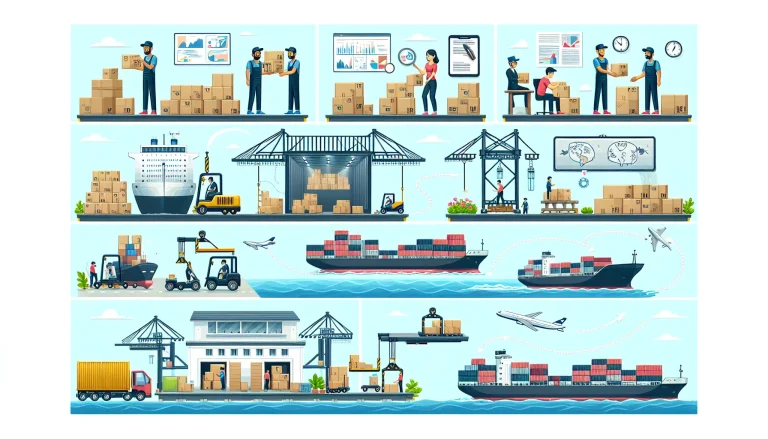Welcome to the rough and tumble world of international shipping business where thrill and challenge collide. For anyone yearning for mastery in this sphere, you don’t need to look further.
Packed with strategic insights and industry secrets, this guide promises to unravel the intricacies of international trade, placing you at the helm of successful global deal-making.
In short, your map to navigate the complex sea routes of global trade starts here. Welcome aboard!
International Shipping Rates
90% of the world's goods are transported by the international shipping industry.
Earn $1,200+/week delivering for local businesses
Driver benefits:
- Steady local business routes
- Weekly pay + tips
- Dedicated support team
- Flexible scheduling
Understanding the Basics of International Shipping Business
Step 1: Grasping the Concept of International Shipping
International shipping isn’t just about cramming goods into a container, shipping labels, and sending packages with tracking numbers with it. It’s a detailed process that allows goods to move across borders while adhering to international trade laws and regulations. Discover the nuances of budget-friendly international shipping, including its benefits and drawbacks, and see how it stacks up against other shipping methods.
The Role of International Shipping
The international shipping business plays a crucial role in the global economy. It’s the backbone of the global supply chain, providing a gateway to overseas markets that might otherwise be unreachable. It allows goods to reach customers with ease and provides an avenue for global trade. In a rush to meet global demand? Speed up your delivery with faster shipping options and get your products worldwide swiftly. Discover the benefits of expedited international shipping today.
Essential Elements of International Shipping
Key elements of international shipping include logistics, regulatory compliance, documentation, and communication. Handling these aspects efficiently can result in successful and profitable international transactions.
Step 2: Identifying Key Players in International Shipping
The international shipping business isn’t an individual sport. It involves several key players which include:
Shipping companies are at the heart of the international shipping business. They are responsible for transporting goods safely and efficiently across the high seas. Understand the benefits of using priority shipping for your international deliveries to ensure your packages are delivered swiftly and securely.
Customs authorities are integral to the shipping process, as they control the movement of goods across borders. They ensure compliance with laws and regulations, collect customs duties on export freight, and prevent smuggling.
Freight forwarders coordinate the transportation of goods, navigating route planning, documentation, and logistics. They work with shippers and transporters to ensure goods arrive safely and on time at their destination.
Step 3: Understanding the Shipping Process
The international shipping process is intricate, involving critical steps from packing goods to delivering them to the buyer’s door doorstep.
Proper packaging and documentation are critical in international shipments. Goods are packed according to international standards to withstand shipping and handling. Documentation includes packages, shipping instructions, bill of lading, and customs and regulatory paperwork.
Upon packaging and documentation, goods from other countries are handed over to shipping lines for transportation. The cargo then undergoes customs clearance at both export and import countries, which involves examination and duty payment.
After clearance, goods are shipped and handed over to the buyer or the appointed representative. This transaction marks the final stage of the international shipping process. Curious about quicker options? Dive into the essentials of shipping overnight, including expenses and timing, to fully understand this expedited service.
Understanding the basics of international shipping can prove beneficial for anyone engaged in global trade. Comprehensive knowledge of the process, key players, and applicable regulations can help navigate complexities and achieve a seamless shipping experience. From here, you’ll be ready to delve deeper into specifics such as navigational regulations and compliance. Unraveling the intricacies of standard international shipping: Discover strategies to manage your shipping efficiently while adhering to global standards to ensure a satisfying and seamless experience for your clients.
The choice between courier services and traditional postal options can significantly impact your shipping strategy. For optimal delivery solutions that cater to different business needs, it’s essential to understand the nuances of each service. A detailed comparison on this subject can enhance your shipping efficacy. Explore more about this in our guide on the differences in business delivery methods, helping you tailor your approach to meet customer expectations effectively.
Merchant Ships
There are approximately 55,000 merchant ships sailing the seas, comprising different vessel types like cargo ships, bulk carriers, and tankers
Shipping Containers
At any given moment, there are at least 20 million shipping containers traveling across the oceans, with 60% of them going to and from Asia.
Navigating Shipping Regulations and Compliance
Importance of Compliance in International Shipping Services
Compliance isn’t an optional side dish in the smorgasbord of international shipping. It’s the main course, and without it, your business can be looking at everything from mild indigestion in the form of fines and penalties to a full-blown business shutdown.
International shipping compliance starts with understanding and implementing international trade laws, customs regulations, and import/export restrictions. The assortments of regulations mean that businesses must keep a constant eye on changes to ensure they remain in compliance. It’s not just about following the rules. Maintaining compliance can also save your business from unnecessary costs and delays.
Capacity of A Single Container Ship
A single large container ship can transport over 200,000 container loads in a year.
The Cost of Ignoring Compliance
Failure to comply can lead to vastly increased shipping costs. Imagine having your goods impounded while you scramble to meet unknown regulations, this not only costs money in fees and fines, but it also puts a chokehold on your supply chain. You can quickly lose clients and tarnish your reputation. In the world of international shipping, compliance isn’t just important – it’s essential.
Understanding the Customs Clearance Process of International Shipping
Navigating international shipping regulations is like learning a foreign language – both require patience, effort, and a reliable source of information. It involves mastering the art of customs, understanding duties and taxes, and staying updated with changing regulatory landscapes.
Customs, Forms, Duties, and Taxes
Shipping internationally means your shipments will be subject to customs duties and taxes. Your shipment might be examined or detained by customs officials; being well-versed with customs documentation can result in faster clearance customs delays and lower charges. The duty and tax rates vary between countries, and tracking these changes can seem like catching a greased pig.
Tips for Ensuring Compliance
Just as sailors use navigational tools to steer their course, shippers can use several strategies to navigate the choppy waters of shipping rules and regulations.
Prioritize education and training for your team. Make sure they’re always brushed up on the latest regulations. This isn’t a one-time thing. Treat it like a subscription service – it needs constant renewal.
Make technology your new best friend. Incorporate software programs that track and notify about regulatory changes automatically. It’s like having a co-pilot, giving you confidence as you navigate the shipping route.
A ship internationally without a map is sailing blindly. Proper documentation serves as the roadmap for your international shipment, ensuring a hassle-free customs clearance. Well-document shipments have a smoother sailing rate.
Embracing compliance in your shipping strategy not only secures your business operations, but it could also give you a competitive edge. As you cast your net wider in the international waters, mastering the art of compliance ensures a steady voyage.
Decoding International Shipping Costs
Factors Influencing Shipping Costs
Begin by exploring the key elements that impact shipping rates. These include the size and weight of the shipment, origin, and destination, shipping needs, the mode of transportation, and potential customs responsibilities. Chances are, you’ll be dealing with dynamic pricing models, where costs fluctuate based on market demand and fuel costs. Discover how fixed shipping rates can simplify the shipping process for businesses and consumers alike by offering a consistent price, regardless of these variable factors.
The cost of international shipping also often varies because of the different handling fees charged by multiple carriers throughout the journey from another country of origin to the destination country. These intermediate handlers might include customs brokers, courier services, or freight forwarders, all potentially imposing fees of their own.
International Shipping Freight
Larger high-tech vessels can cost upwards of $200 million to build, and the shipping industry generates over half a trillion dollars in annual freight rates.
The Impact of Fuel Costs on Shipping
Fuel costs are a significant factor to consider when discussing shipping expenses. They can drastically influence the total shipping cost as carriers typically align their fuel surcharges with global oil prices. Keep an eye on these, as fluctuations can result in sudden changes in shipping expenses.
How to Calculate Shipping Costs
International shipping costs are based on various factors that form a multi-faceted formula. This typically includes the base rate, which is determined by the shipment’s weight, size, and distance. The formula also considers any additional services that may be required, such as packing of the international package or insurance. Discover various international shipping method options, their associated costs, delivery timelines, and tips for selecting the most suitable option for your needs.
Weight and size are usually calculated using either actual or dimensional weight, whichever is greater. The destination when shipping overseas is a significant variable, as shipping to some locations may incur additional duties and taxes. The mode of transportation, whether air, sea, or land, adds to the final cost.
Tips for Reducing Shipping Costs
Reducing shipping costs can make a significant difference in improving your business’s bottom line. Start by comparing the rates of different carriers and consider consolidating shipments to save on cost per unit. Make sure to measure and weigh your shipment to avoid additional charges accurately. Consider prepaid shipping, which carriers often offer at a reduced rate.
Consider the possibility of outsourcing to a third-party logistics provider (3PL). A 3PL can typically negotiate lower rates due to the volume of shipments they manage. This, in combination with their relationships with various carriers, can land you a much better deal than negotiating rates on your own.
Developing a Successful Shipping Strategy and Logistics
Importance of a Solid Shipping Strategy
Shipping isn’t just about moving goods from point A to point B. It forms the backbone of an international business, supporting operations and contributing to overall success.
A steady shipping strategy is critical; without it, you’ll be blindfolded navigating the intricate world of international commerce. It’s like a map, creating a defined route to guide your business decisions, keep you compliant, and help cut costs while ensuring customer satisfaction. But all that isn’t a walk in the park.
Coming off the back of learning about international shipping costs, it’s of note that a well-laid shipping strategy can also assist in managing these expenses. It’s a marathon, not a sprint.
Key Elements of a Shipping Strategy
Every shipping strategy must be custom-built and catered to the unique needs of a business. However, there are some fundamental elements that no shipping strategy should overlook.
Placing the customer at the center of your strategy is the first rule of thumb. An outstanding customer experience can ultimately dictate your business success. It encompasses delivery speed, tracking capabilities, returns, and pricing – all elements should be optimized for positive interactions with your customer.
International shipping comes wrapped with regulations. From customs rules to documentation requirements, ensuring regulatory compliance is crucial to avoid fines, penalties, or shipping disruptions. Companies should stay informed about international shipping laws and work towards ensuring that all procedures conform to these laws.
Cost Optimization
Cost-effectiveness is key in any business operation, and shipping is no exception. Striking a balance between providing quality shipping service and managing costs can be a tussle. A well-outlined strategy can help guide these decisions, providing ways to optimize shipping costs without sacrificing the customer experience.
Implementing Effective Logistics
Turning a concept into reality often requires more than just a plan. Implementation is where the majority fall short. Effective logistics execution involves meticulous planning, seamless communication, reliable technology, and tracking.
Planning and Communication
Efficient logistics starts with effective planning and excellent communication. A well-drafted plan, clearly communicated to all parties involved – carriers, customs, warehouse staff, and customers – can help keep operations error-free and efficient.
Today, technology is intrinsically linked to successful logistics. Leveraging tools like management software, GPS tracking,call management systems, and data analysis can automate operations, reducing errors and improving efficiency.
Tracking and Evaluation
Finally, implementing a system to track progress and evaluate performance can help uncover areas for improvement. Regular evaluation ensures that logistics operations remain efficient and up-to-date, and continue to serve customer needs effectively. Discover the transformative power of omnichannel logistics strategies in enhancing the efficiency and adaptability of your fulfillment process.
By understanding and implementing these elements, businesses can navigate international shipping more confidently, manage costs, and ensure customer satisfaction. Time to brace yourselves for the world of international shipping challenges ahead.
International Shipping Service
Shipping is the safest form of commercial transport, with the industry adopting international safety standards as early as the 19th century.
Overcoming International Shipping Challenges
Common Challenges in International Shipping
Today’s globalized economy inevitably comes with a series of difficulties as businesses attempt to send goods across national and continental borders. 1 in 3 companies, for instance, must navigate through complex customs processes, illuminating the difficulties of international shipping. Discover the advantages and disadvantages of 48-hour delivery in this intricate world of international logistics.
Navigating Customs Regulations
Navigating customs regulations is a minefield for novices in the international shipping business. Different countries have unique rules, documentation requirements, and varying tariffs, which can result in unexpected costs, delays, and the potential loss of goods. Understanding these regulations is vital in ensuring your products reach their destination without a hitch.
Practical Solutions to Shipping Challenges
Overcoming these challenges requires a proactive approach and a sound understanding of the shipping industry’s inner workings.
Hiring Expert Freight Forwarders
To navigate the intricacies of international trade, businesses can benefit from hiring expert freight forwarders. These professionals take the brunt of the logistical burden, from handling paperwork to managing cargo transport. They act as invaluable liaisons, ensuring smooth global trade operations.
Leveraging Technology in Shipping
Over the past decade, technology has revolutionized virtually every business sector, and international shipping is no exception. From streamlining operations to enhancing tracking information, tech innovations are transforming shipping methods. Interested in how international delivery is becoming greener? Discover the role of shipping with net-zero carbon emissions in transforming the sustainability of the global logistics industry.
Utilizing Data Analytics
Data analytics can dramatically enhance shipping efficiency by providing insights into shipping routes, delivery times, and other key metrics. For example, by analyzing data from various shipping lines, businesses can optimize their routes, improve timeliness, and reduce costs.
Implementing Real-Time Tracking
Emerging technology is also facilitating real-time package tracking, enabling businesses to provide accurate delivery estimates to new customers and instantly locate items during transport. Real-time tracking can bolster customer trust and reduce the likelihood of lost shipments.
Remember, as the saying goes, a smooth sea never made a skilled sailor. The challenges inherent in international shipping can indeed be overwhelming, but with a strategic approach, the right partners, and the proper application of technology, you have every tool you need to navigate the rough waters.
Navigating the Future of International Shipping
Understanding the international shipping landscape, recognizing crucial factors like regulatory compliance, shipping and handling costs, and partnering with reliable carriers form the cornerstone of any successful shipping business. Explore various shipping method types to ensure your business chooses options that balance speed, cost, and dependability, ultimately enhancing customer satisfaction.
All these elements play a crucial role in enabling you to offer exceptional services to your customers, ensuring they receive their products in pristine condition and in a timely manner. It’s clear – a deep grasp of the international shipping domain isn’t just advantageous – it’s fundamental. Adopting Click and Collect as a shipping option amalgamates the efficiency of online shopping with the immediacy of in-store pickup, significantly elevating your service offering to customers.
Now your voyage begins – defining your shipping policy, selecting your freight forwarder, and preparing your very first consignment. Each successful sea journey starts with a single brave nautical mile. Rest assured – with the knowledge at your disposal, you are set to chart a lucrative course.
How will you translate this newfound understanding into action? Perhaps by outlining your global shipping strategy, or by examining your current shipper contracts? Your next move in the vast ocean of international shipping awaits.
Lastly, remember this, as a momentous philosopher once said ‘A smooth sea never made a skilled sailor’. Combating the waves of the shipping world might be tricky, but with perseverance and a steadfast approach, you’ll find yourself navigating successfully.












